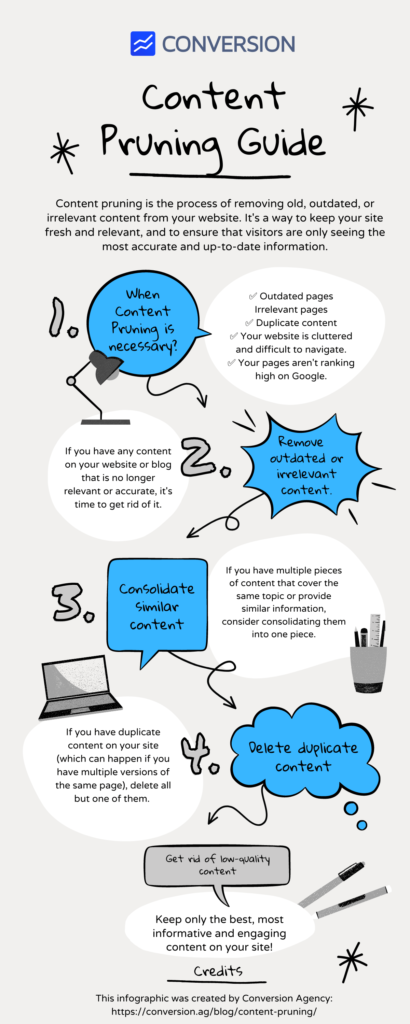Content pruning is the process of removing old, outdated, or irrelevant content from your website.
Content pruning is the process of removing old, outdated, or irrelevant content from your website. It’s a way to keep your site fresh and relevant, and to ensure that visitors are only seeing the most accurate and up-to-date information.
There are a few different ways to approach content pruning. You can go through your site systematically and remove any content that doesn’t meet your criteria for being useful or relevant. Or, you can take a more reactive approach and only remove content as it becomes outdated or no longer useful.
Either way, content pruning is an important part of maintaining a high-quality website. It’s especially important if you regularly publish new content, as this will help ensure that your site doesn’t become cluttered with old information.
If you’re not sure where to start with content pruning, consider taking an inventory of all the content on your site. Then, create a plan for how often you want to review and update each piece of content. Finally, put together a system for tracking when each piece of content was last updated so you can easily see which pieces need attention.
Google Helpful Content Update
In late 2022, Google has announced a new update to their algorithm that will give preferential treatment to websites with fresh, relevant, and helpful content. This update is designed to improve the quality of search results by giving users more accurate and up-to-date information.
As part of this update, Google will be looking at a number of factors to determine whether or not a website’s content is fresh, relevant, and helpful.
The ranking factors
Some of these factors include:
– The age of the content: Google will be giving preference to websites with content that is less than 6 months old.
– The relevance of the content: Google will be looking for content that is relevant to the user’s query.
– The helpfulness of the content: Google will be looking for content that is truly helpful to the user, rather than just being a sales pitch or advertisement.
If you want your website to benefit from this update, then it’s important to start thinking about how you can create fresh, relevant, and helpful content. One way to do this is by creating informative blog posts or articles that are related to your business or industry.
Our infopgrahic about Content Pruning

The Benefits of Content Pruning
There are many benefits to content pruning, including:
- Improved search engine visibility: When you prune your content, you remove outdated and unnecessary information that can drag down your site’s search engine ranking. By keeping your content fresh and relevant, you’ll attract more visitors and improve your chances of appearing in the top search results.
- Greater engagement: Up-to-date content is more likely to engage readers and encourage them to stick around. If your website is full of outdated information, visitors may get turned off and go elsewhere.
- Increased efficiency: Maintaining a large website can be time-consuming and expensive. Pruning your content can help you streamline your site and save money on hosting and other costs.
- Better usability: A well-organized website is easier for users to navigate and use. By pruning your content, you can make it easier for visitors to find the information they’re looking for without getting overwhelmed or lost.
When and How to Use Content Pruning
As we said, content pruning helps improve your site’s overall quality, make it easier to manage, and make room for new content.
There are a few different ways to identify which content on your site could be considered low-quality or outdated. One way is to simply look at the date when the content was published. If it’s more than a few years old, chances are it’s no longer relevant to your audience.
Another way to assess the quality of your content is to consider how much traffic it’s getting. If a particular page or post isn’t getting much traffic, it may be an indication that it’s not useful or interesting to your readers.
Finally, you can also ask yourself whether the content is still accurate. Outdated information can mislead your readers and reflect poorly on your brand. If you’re not sure whether a piece of content is still accurate, consider doing some research to find out.
Pruning your content
Once you’ve identified which pieces of content on your site could be improved or removed, it’s time to take action. With outdated content, you have a few options:
You can update the information to make sure it’s still accurate. This is a good option if the rest of the content on the page is still relevant and useful.
You can remove the outdated content completely and replace it with something new. This is a good option if the entire page is
When Content Pruning is necessary?
There are a few different scenarios where content pruning may be necessary:
-Your website has pages with outdated information.
-You have pages on your site that are no longer relevant.
-You have duplicate content on your site.
-Your website is cluttered and difficult to navigate.
-Your pages aren’t ranking high on Google.
If any of these apply to your website, then it may be time to consider pruning some of your content. But how do you know which content to remove? And what’s the best way to go about doing it? Keep reading to find out.
Examples of Content Pruning
When it comes to content pruning, there are a few different ways you can go about it. Here are a few examples of content pruning to help give you an idea of what it is and how it can be beneficial:
1.Remove any outdated or irrelevant content.
If you have any content on your website or blog that is no longer relevant or accurate, it’s time to get rid of it. This could include old blog posts, pages that are no longer needed, or even entire sections of your site that are no longer useful.
2. Consolidate similar content
If you have multiple pieces of content that cover the same topic or provide similar information, consider consolidating them into one piece. This will make your site more streamlined and easier for visitors to navigate.
3. Delete duplicate content
If you have duplicate content on your site (which can happen if you have multiple versions of the same page), delete all but one of them. Keeping multiple copies of the same page confuses search engines and can hurt your ranking in search results.
4. Get rid of low-quality content
If you have any low-quality or thin content on your site, it’s time to ditch it. This includes anything that’s poorly written, doesn’t offer much value, or is just plain boring. Keep only the best, most informative and engaging content on your site to ensure visitors keep coming back for more.
Conclusion
Content pruning is an important part of any content marketing and SEO strategies. By regularly removing old and outdated content, you can ensure that your website or blog remains relevant and up-to-date. Not only does this improve the user experience, but it also helps to boost your SEO rankings. If you’re not already doing it, start content pruning today and watch your website reach new horizons.
